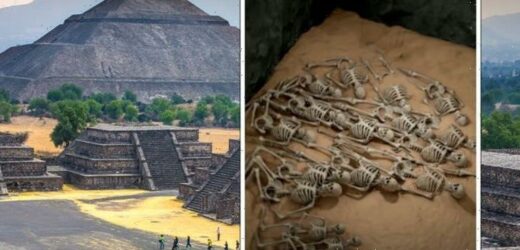Lost Pyramids of the Aztecs explores the wiping out of the Aztecs
We use your sign-up to provide content in ways you’ve consented to and to improve our understanding of you. This may include adverts from us and 3rd parties based on our understanding. You can unsubscribe at any time. More info
The Aztecs were a Mesoamerican culture that flourished in Central Mexico in the period between 1300 to 1521. They were made up of multiple different ethnic groups of the region, especially those who spoke the Nahuatl language. Aztec culture was organised into city states, some of which joined to form alliances, political confederations and even empires.
These large cohesive social creations left their mark on the land, most often in the form of great cities and stone structures, like pyramids and temples.
Many of these pyramids remained elusive to researchers for years, but recently, modern technology has enabled researchers to look inside the structures without ever having stepped a foot in them.
Archaeologists previously tunnelled into the bedrock of the Pyramid of the Sun, at first believing what they had found was a natural cave, but quickly realised they had found an intricate system of tunnels.
Secret tunnels and passages have since been found in other pyramids, including the Temple of Quetzalcoatl, also known as the Feathered Serpent pyramid, in the Aztec city of Teotihuacan.


Discovered by archaeologist Sergio Gómez in 2017, his work since has turned up countless ancient artefacts and the more gruesome discovery of human remains.
His work was captured in a Discovery UK documentary, in which the narrator noted: “Within the Feathered Serpent pyramid, inside the central cell, is a dark secret.”
Here, 20 skeletons were found, almost completely intact, carefully arranged in what looked like a symbolic pattern.
These remains were not alone: over 260 bodies were found to be built unto the fabric and foundation of the building.
The narrator noted: “The pyramid is a mass grave.”
JUST IN: Archaeologists stunned by ancient Myanmar monument

It is unclear why exactly these humans were killed.
They may have been sacrificed to the gods, or simply died of natural causes.
In order to access the remains and the objects found, Mr Gómez and his team had to remove 1,000 tonnes of soil in order to access the tunnels.
They believe the Aztecs likely deposited the dirt as a way to seal off any access points.
This meant that most of the artefacts found were largely undamaged and untouched by robbers.
DON’T MISS
Aztec discovery stunned archaeologists after ‘treasure trove’ find [REPORT]
Yellowstone eruption warning: Human brains could be ‘popped apart’ [INSIGHT]
Brexit Britain win as experts ‘astounded’ by battery results [ANALYSIS]


Mr Gómez explained: “We’ve been working very carefully using lots of small tools so that we don’t lose any of the riches that we uncover.”
He came across two ancient pots which had not been touched for at least 1,800 to 2,000 years.
When combined, his team found more than 100,000 objects along the tunnel, describing them as extraordinary objects,” and noted that, “some of them [have] never [been] seen before in any Mexican archaeological exploration”.

The artefacts included a greenstone crocodile teeth, crystals shaped into eyes, as well as sculptures of jaguars.
And, the tunnel itself was something of an artefact.
Lined in iron pyrite, it reacted to any light by shimmering like the night sky, a reaction likely purposefully induced by the Aztecs in order to replicate the stars.

While the Aztecs flourished for hundreds of years, by the early 16th century, their empire started to come undone.
Invaders led by the Spanish conquistador Hernán Cortés overthrew the Aztec Empire by force and captured Tenochtitlan in 1521.
This finally brought to an end Mesoamerica’s last great native civilisation.
Source: Read Full Article
